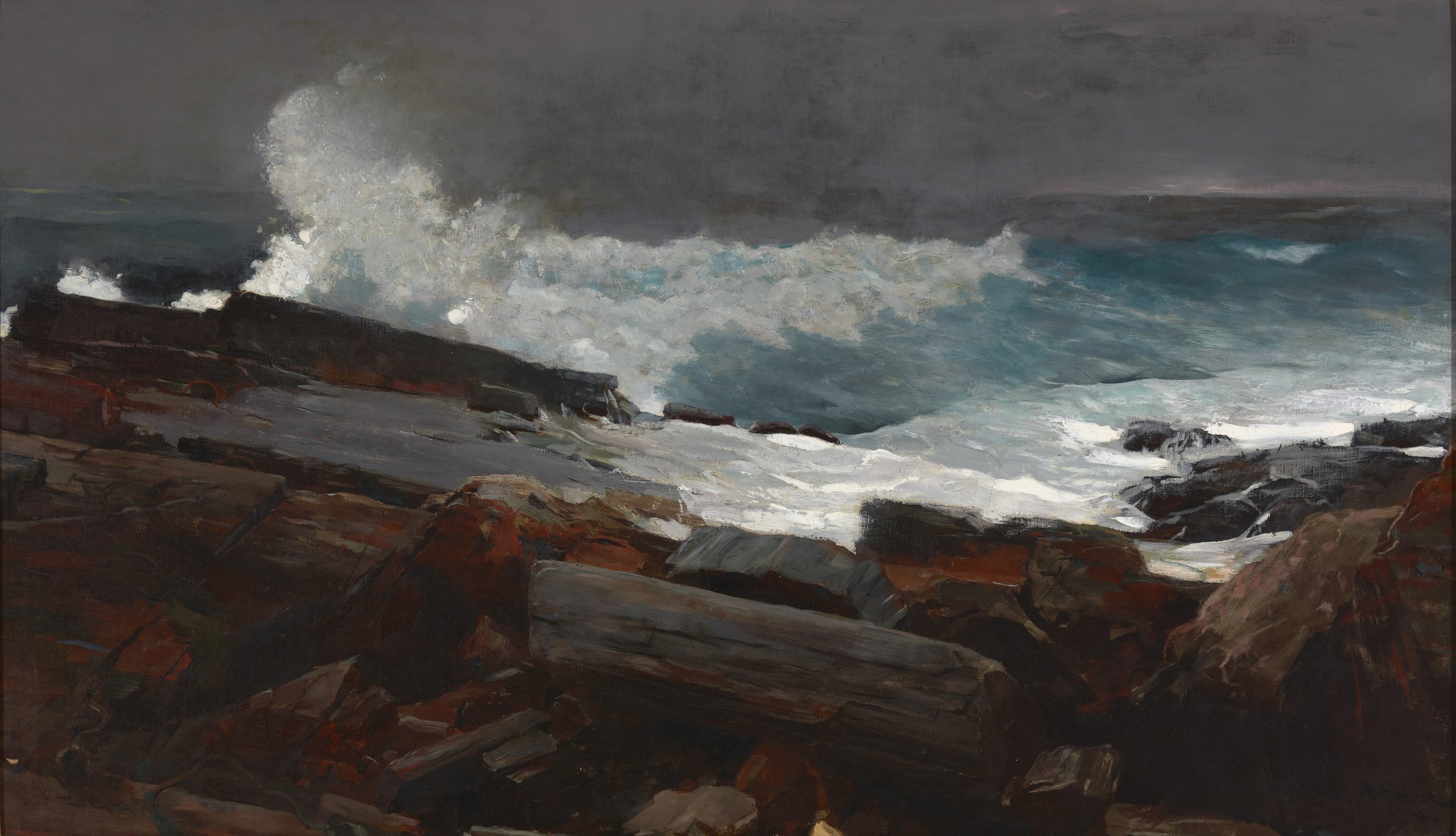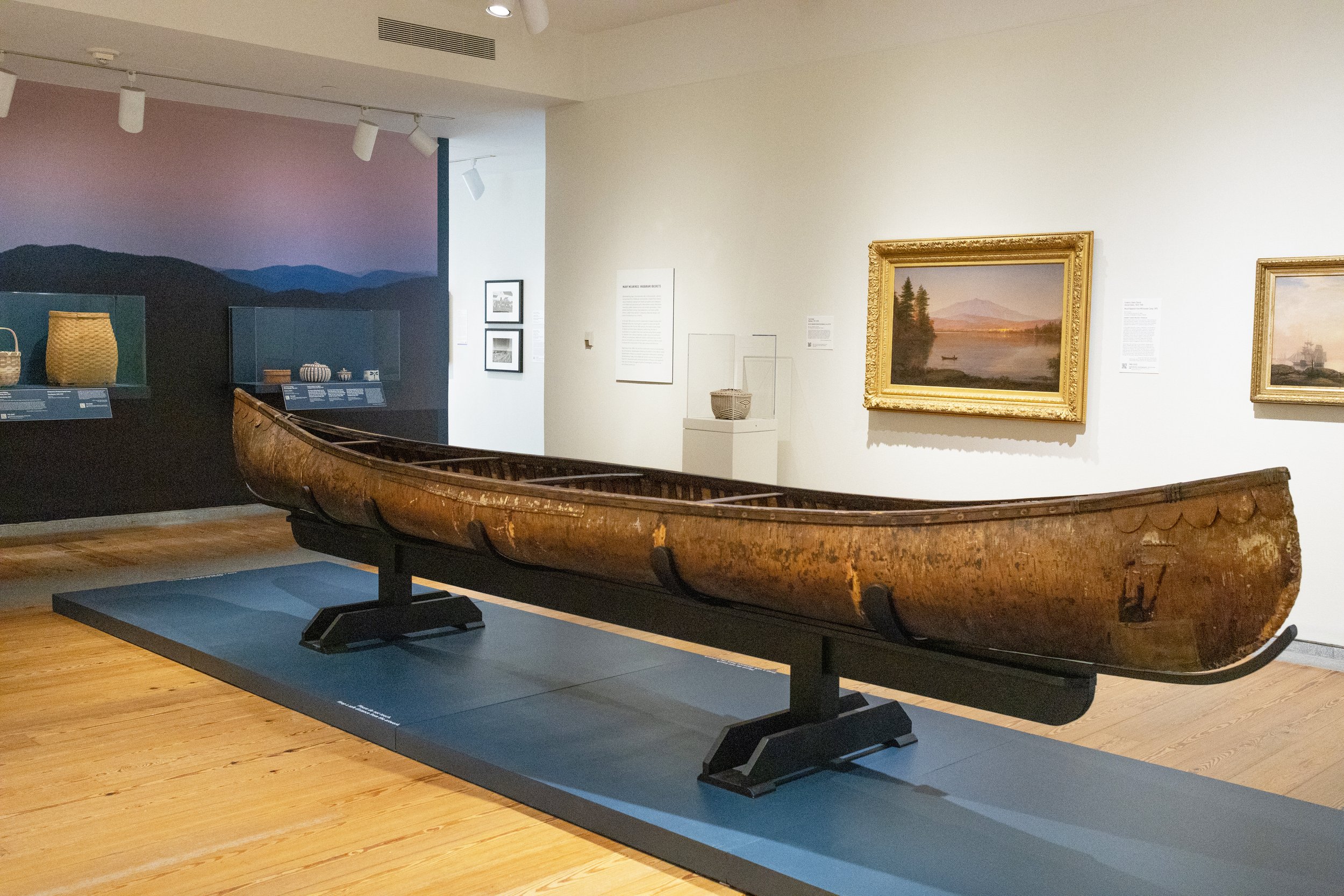Boston Globe: The fine art of remaking a collection
Faced with holdings out of step with the times, museums everywhere are doing the hard work of catching up
Winslow Homer, “Weatherbeaten,” 1894. A new installation at the Portland Museum of Art brings new perspectives to one of the museum's signature works. PORTLAND MUSEUM OF ART, MAINE
By Murray Whyte, Globe Staff
Updated October 20, 2023
PORTLAND, Maine — A 19th-century birchbark canoe bisects the main gallery space in “Passages in American Art,” a reinvention, just a few months old, of the Portland Museum of Art’s permanent collection. A potent symbol of millenia of Indigenous presence here — the museum identifies it as Penobscot — the canoe sits in clear view of the museum’s more familiar treasures: Fitz-Henry Lane’s “Castine Harbor,” 1852, Gideon Eldon Bradbury’s “Logging the Saco,” from the 1870s, as though gliding by long-idealized visions of American shores. The friction between them is palpable, and deliberate: Ideal for whom? And at what cost?
“Passages” refracts American art through multiple lenses at once: Cherished favorites like Winslow Homer’s “Weatherbeaten,” a craggy shore exploding with icy surf, comes with a stern lament on a wall label from Passamaquoddy scholar Chris Newell, about so much of the Maine shoreline being privately owned and with no public access. His words share space with a warning from the Gulf of Maine Research Institute’s Jonathan Labaree, about the rapidly rising tides in the region due to climate change. Marguerite Thompson Zorach’s 1935 painting “The Woolwich Marshes,” a spectacularly expressive, flatly modern seaside landscape rimmed with electric pink and green, is accompanied by words from Gayle Bowness, the GMRI’s municipal climate action program manager, describing both the significance and fragility of the marsh ecosystem. Nearby, an array of Wabanaki basketry hangs on a wall blanketed floor-to-ceiling with a photomural by the Mi’kmaq artist Jared Lank — a direct link, the wall text says, “between these art forms and the woods and waters that sustain them.”
Installation view, "Passages in American Art," Portland Museum of Art. PORTLAND MUSEUM OF ART
“Passages” is not an experiment, but a blueprint for the guiding principles of a fully reimagined PMA, which will add a new 60,000-square-foot wing, due to break ground in 2026. It gathers in a breadth of works across materials and eras, tied together only by an expansive notion of what American art even is. It’s intended, permanently, as a work in progress: The museum means to let “Passages” evolve organically and indefinitely through consultation with a diverse community board.
“This is a big shift,” said Shalini Le Gall, the museum’s chief curator. “I’m an art historian, but art history is not the only way to access art in a museum. We want to show people that art by its nature is not stable, and the scope of interpretation will always be changing.”
“Passages” is no outlier. Museums of all scales, all over the country, have been engaged in the long, slow process of shifting their roles from guardians of a static version of history to places of dynamic, and sometimes problematic, flux, for some time. That’s meant chipping carefully through permanent collections both for blind spots and opportunities to engage a more complex reality, past and present.
“Passages” with its priority on presenting Indigenous practice as parallel to conventional art history, is a recent emblem of a trenchant shift. Pandemic-era eruptions around social justice brought sudden urgency to what had been incremental processes, and a renewed vigor for redefining “American” itself. The Peabody Essex Museum opened a full reinstallation of its American collections in early 2022 that gathered in Native American and Black experiences alongside conventional colonial art histories. The MFA’s, newly-reinstalled 20th-century American collections opened last summer with a display divided into six unconventional categories. One, “Folk Meets Modernism,” is a fresh and unorthodox insertion of the maligned realm of folk art alongside American masters like Joseph Cornell. Another, the cross-cultural “Nature Abstracted,” folds the sumptuously organic work of artists like Georgia O’Keeffe in alongside a signature painting by the Anishinaabe painter Norval Morrisseau.
But even before those reckonings, institutions, broadly, had identified a problem. Four years ago, I was one of many to note that the newly reopened permanent collection galleries at New York’s Museum of Modern Art — closed for more than six months — were replete with new works by women, and by artists of diverse backgrounds, many of them acquired during the closure.
But few museums have the luxury of a sustained pause and an open checkbook. Instead, most rely on creative and more modest strategies to reconfigure their public selves, while acknowledging that change will not be a grand gesture, but an incremental, permanent undercurrent.
In Portland, “Passages” does well to signal its intentions, while leaving more than a few dangling threads. The installation seems to stall in a chapter about the American West, where a painting of the divine majesty of the Yosemite Valley by New Englander and Manifest Destiny true believer Albert Bierstadt has too little to directly challenge its glorified visions of westward expansion.
In Rockland, Maine, the Farnsworth Art Museum’s 75th anniversary this year brought its own bout of self-examination. “We were really soul-searching,” said director Christopher Brownawell. “An institution needs to be in its moment, and we had lost ground.”
Plunging deep into the museum’s holdings, the Farnsworth identified six paintings by the artist Lynne Drexler, held in storage for years. A Maine-based painter of vibrantly organic abstract works who died in 1999, Drexler had been overlooked much of her life, often selling blandly pleasant seascapes to tourists who descended on Monhegan Island, where she lived, to make ends meet. But she had recently been rediscovered by a ravenous contemporary art market constantly in need of new product.
Drexler’s rising reputation presented the Farnsworth with an opportunity. With six in its collection, it decided to sell two. The proceeds — one sold for $1.2 million in March, 2022; the second for $1.5 million in May that year — Brownawell said, went to restoring, framing, and finally putting on view their remaining four Drexler works. Critically, it also established the museum’s Lynne Drexler Acquisition Fund, which the museum has since used to acquire dozens of works by contemporary artists in Maine.
The strategy has revitalized the museum’s display: When I was there over the summer, the new works made for a fresh and invigorating experience. “Our role is to celebrate Maine’s role in American art, and that narrative arcs forward as well as back,” Brownawell said. “It’s a difficult conversation when you have to admit you haven’t done as well as you’d like when it comes to representing the more diverse, more dimensional understanding of American art that you’d like to. So it’s been incredibly gratifying to be able to do that.” Drexler’s name is on every addition, paying respect to what her work continues to generate.
Deaccessioning, or selling collection pieces, has drawn attention in recent years as a controversial practice. But it has always been a vital part of collections management, and maybe never more so than right now. The MFA last year announced its intent to sell two paintings by O’Keeffe and one by Charles Sheeler — it has several more, by both artists — to bolster neglected realms. The most significant acquisition thus far has been “Tailleur pour dames,” a 1957 painting by Remedios Varo, a Spanish Surrealist painter who fled war in Europe for Mexico in the early 1940s. It’s now on view in the museum’s first-ever permanent collection gallery devoted to modern Latin American art.
The MFA has tread cautiously in its more sacrosanct spaces. In its galleries devoted to John Singer Sargent, Kehinde Wiley’s “John, 1st Baron Byron,” a 2013 portrait of a young Black man, hung until recently near Sargent’s nude oil sketch of Thomas McKeller, the Black man who modeled for Sargent’s neoclassical murals in the MFA rotunda. In the main floor historical galleries, Thomas Sully’s epic painting “The Passage of the Delaware,” 1819, of George Washington leading his troops in the definitive surprise attack on the British, now shares space with Alison Saar’s contemporary prints depicting Black women, and a small vitrine containing select Indigenous artworks: a 300-year-old Ojibwe club, and a fiery Apsáalooke deer and porcupine hair roach from the 1880s. .
At Dartmouth’s Hood Museum of Art, the footprint is far from light. A rotating display of its permanent collection fastens history to contemporary reality in often confrontational terms: The current installation looks broadly at water, both as commodity and cultural force; a 2017 painting by Yatika Starr Fields, of the moccasin-clad feet of female Lakota waterkeepers who opposed the Dakota Access Pipeline, hangs next to a radiant 1878 landscape by Lemuel D. Eldred, as just one example.
More jarring is the museum’s exhibition “The Great Mystery,” with the Cree artist Kent Monkman. Hood curator Jami Powell invited Monkman to respond to works in the collection itself. Monkman, whose sharp, satirical takes on art history infuse standard narratives with Indigenous perspective, chose a canonical piece by Abstract Expressionist Mark Rothko, and a bronze maquette of Cyrus Dallin’s “Appeal to the Great Spirit,” a Native American chief on horseback with arms outspread, a classic victim’s pose (the full-size sculpture has sat on the MFA’s front lawn since 1912).
If the Rothko is as close to sacred as American art gets, Monkman is clearly, intentionally profane. Monkman remade Rothko’s piece, an exacting copy to scale, then painted Dallin’s chief on top of Rothko’s pale fogs of color. In his version, the chief hunches in a confused shrug. Dallin’s is not the Indigenous experience Monkman knows, it seems to say.
It’s a refutation couched in good humor, an invitation to reconsider history as fluid, not static. “Kent acknowledges and then playfully challenges a lot of long-held notions,” said Powell, who is Osage. “I think he allows us to ask: What do we do with things like this — that we know are important, but why?” It’s the question of our time, finally being asked everywhere.


